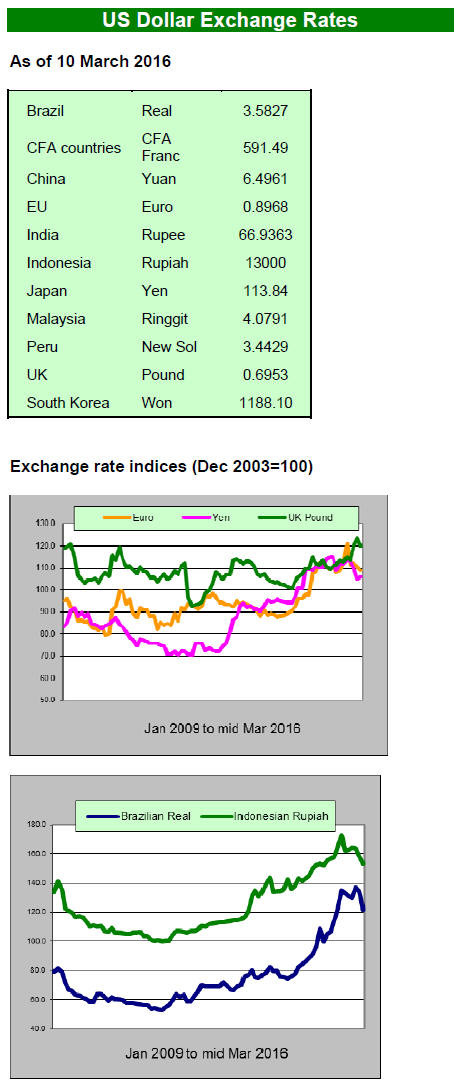2. GHANA
Centre aims to make Ghana preferred
investment
destination in Africa
The Ghana’s Mission to the United Nations recently
organized an investment forum as part of activities to mark
Ghana’s 59th independence anniversary.
Ghana’s Minister for Private Sector Development, Dr.
Abdul Rashid Pelpuo detailed the country’s wealth of
natural resources including timber, supportive investment
laws and socio-economic stability as advantages for
potential investors.
Mrs. Mawuena Trebarh, Chief Executive Officer of the
Ghana Investment and Promotions Centre (GIPC) said
procedures for setting up businesses in Ghana were
straight forward.
The Ghana Investment Promotion Centre (GIPC) recorded
appreciable levels of Foreign Direct Investment (FDI)
inflows in 2015 after 2 years of implementing the new
investment law, the GIPC Act, 2013 (Act 865).
Highlights of recorded investments have been published
by the GIPC and show that 170 projects had been
registered worth an estimated US$2.68 billion in 2015.
The potential for job creation from registered projects in
2015 was 14,948, an increase of 14% year on year.
GIPC says “As part of our strategy for 2016, the GIPC
will focus on improving upon its operational efficiency,
provide higher level services and roll out the second phase
of our "Think Ghana Make it Happen" campaign with the
target of propelling Ghana to become the preferred
investment destination in Africa.”
For more see: http://www.gipcghana.com/
Manufacturing could find a sound footing says
industry association
In a related development, an analysis by the Association of
Ghana Industries (AGI) on manufacturing activities in the
country last year noted the decline in output.
The report said the AGI was confident the sector could get
onto a sound footing if the government addresses the high
rate of inflation, stabilises the exchange rate and creates
conditions for a lowering of interest rates. The basis for
sustained expansion of manufacturing rests, says the
association, on addressing the severe power shortages
currently being experienced.
Risk to regional trade as neighbours try to stablise
economies
Ghana has placed a ban on imports of many items from
Nigeria, including oil, apparently in response to what is
considered the unreasonable move by Nigeria’s “Import
Prohibition list” which is being used to limit the amount of
foreign exchange provided to Nigerian importers. Ghana is
Nigeria’s regional largest trade partner importing a high
proportion of Nigerian oil output.
The moves by each country will weaken regional trade as
Ghana and Nigeria are said to account for about 70% of
the GDP in the ECOWAS countries.
For more see:
http://venturesafrica.com/here-is-what-ghanas-ban-on-nigeriangoods-
means/
Mid-March prices
Prices for wood products remained unchanged as of 30
January.


3. MALAYSIA
Furniture makers urged - explore
markets for solid
wood furniture in China
The Minister of Plantation Industries and Commodities,
Douglas Uggah Embas, has urged furniture manufacturers
to work together and promote Malaysian furniture so that
the 2020 target of RM53 billion (approx. US$12.9 billion)
export earnings can be achieved.
Malaysia's timber and timber product exports rose by 6.3
per cent to RM21.7 billion (approx. US$ 5.3 billion) in
2015 from RM20.4 billion in 2014.
Chua Chu Chai, Chairman of Export Furniture Exhibition
2016 (EFE), recommended that Malaysian furniture
manufacturers should explore markets for solid wood
furniture in China as consumers there appreciate solid
wood furniture and China's consumption is expected to
grow by five to six per cent this year.
Chua was speaking as he promoted the EFE 2016, a fourday
exhibition themed 'Fine Furniture World Market'.
Expanding chip and particleboard production
As a sign of growing optimism, a major producer of
particleboard and particleboard based products,
HeveaBoard, announced plans to invest RM 20 million
(approx. US$ 4.9 million) to increase capacity.
HeveaBoard utilises rubberwood residues and has
subsidiaries producing downstream Ready-to-Assemble
furniture manufacturing and other panel products.
In 2015 Heveaboard exported about 80% of its
particleboard production mainly to China, Japan, South
Korea, India. Most RTA items are for Japan, Europe,
Australia and the United States.
2016 export quota for ramin and gaharu
The Malaysian Timber Industry Board (MTIB) has
announced a 10,000 cu.m, 2016 export volume quota for
ramin (Gonystylus spp.) products.
The export quota for Karas/Gaharu (Aquilaria spp.)
products, including wood chips, wood blocks and essential
oils is 150,000 Kg for 2016.
Importing timber under TLAS
The MTIB has announced new import regulations for logs,
large square and scantlings as well as plywood. With
effect from 1 January 2016, applications for import
licenses for logs, large square and scantling and plywood,
shall include documentation on source to ensure only
legally harvested timber and products enter the country.
This regulation is to fulfil the requirements of Malaysia’s
Timber Legality Assurance System.
Coming down heavy on illegal operators
Sarawak State Forestry Director, Sapuan Ahmad, is on
record as saying the department will hit hard those
companies found using illegally harvested logs once the
one year grace period since the endorsement of a new
forest ordinance ends in April 2016.
The Forests Ordinance 2015 includes provision for tough
penalties. For example, anyone operating an unregistered
sawmill could face a penalty of between RM500,000 and
RM10 million and/or imprisonment.
The state has introduced an enhanced tracking system
through which timber taken from licensed areas must be
certified and royalty stamped at one of the 48 ‘One-Stop
Compliance Centres’ (OSCC) across the state.
It is understood that the police force, Marine Department,
Malaysian Anti-Corruption Commission (MACC) and
Sarawak Forestry Corporation (SFC) will assist track and
seize illegal logs.
4. INDONESIA
Number of accredited SVLK assessors
continues to
grow
Currently there are 16 independent SFM assessors and 21
timber legality verification companies/bodies accredited
by the National Accreditation Committee (KAN). As the
numbers of accredited assessors grows so does the
credibility of the county’s Timber Legality Assurance
System.
Claims of circumvention of SVLK
Forest Watch Indonesia, an Independent Forestry
Monitoring Network and the Environmental Investigation
Agency have released a report entitled ‘Loopholes in
Legality’ which claims unscrupulous traders have
exploiting the Ministry of Trade Decree allowing SMEs to
export without full SVLK verification. The Decree also
removes the requirement that companies register with
Indonesia's Forestry Industry Products Exporter Registry
(ETPIK).
The report ‘Loopholes in Legality’ claims SME export
declarations are being used by companies that are not
members of the Indonesian Furniture and Craft
Association (Association of Indonesian Furniture and
Handicraft or AMKRI).
For more see:
http://jpik.or.id/shadowy-brokers-exploit-loopholes-in-ministerof-
trade-decree-threatening-indonesias-timber-laws-and-aneutrade-
deal/

5. MYANMAR
Preparing for VPA negotiations
A Gap Assessment Workshop on Myanmar’s Timber
Legality Assurance System was conducted by the
Myanmar Forest Certification Committee (MFCC) and the
EU-FAO-FLEGT Programme on 3 March 2016 in
Yangon.
The Secretary of the MFCC, Barber Cho, in addressing the
workshop said the assessment was helpful to the VPA
negotiation team since members would be better equipped
to understand the situation in terms of gaps between the
existing TLAS and compliance and between the existing
TLAS and VPA-TLAS.
MFCC conducted a further public consultation on SFM
and C&I for both natural and plantation forests) on 4th
March and managers from the Forestry Department and
Extraction Agency Managers from the Myanma Timber
Enterprise attended along with representatives from FSC
and PEFC. Expectations are high for a policy shift towards
forest conservation by the new NLD-led government.
Barter trade in Northwest to be halted by India
The border trade between India and Myanmar has been
affected by a decision by Indian authorities to restrict trade
facilitation to the formal banking system. Until the change
much of the cross border trade was made possible through
acceptance of an ‘informal’ barter system.
Beginning early December 2015 all trade had to be settled
through the formal banking system or the Asian Clearing
Union, a regional cross-border payment network.
Analysts comment that it will take time for the new
regulations to be implemented as the formal banking
system in rural Myanmar is not well developed.
In related news, an additional four foreign banks have
been granted licenses in Myanmar bringing to 13 the
number of international banks in the country. The latest
additions are the Bank for Investment and Development of
Vietnam, State Bank of India, Sun Commercial Bank
(Taiwan P.o.C) and Shinhan Bank (South Korea).

6.
INDIA
First cities under ‘Smart City Programme’
selected
CREDAI has welcomed the selection of the cities for the
first round of development as ‘smart cities’saying this
initiative provides a tremendous opportunity for the real
estate sector especially in the affordable home market.
Bhubaneswar, Pune, Ahmedabad, Chennai and Bhopal
have been selected as the first batch for the ‘Smart City’
programme. The New Delhi Municipal Council (NDMC)
is also included for the first round of development.
Jaipur, Surat, Kochi, Jabalpur, Visak hapatnam, Solapur,
Davanagere, Indore, Coimbatore, Kakinada, Belagavi,
Udaipur, Guwahati and Ludhiana are the other cities
selected in the first batch. Realtors see business
opportunities in all ‘Smart City’ projects.
See:
http://www.credai.org/sites/default/files/Realtor%20see%20big%
20opportunity.pdf
The Centre for Science and Environment, quoting the
Ministry of Housing and Poverty Alleviation, said there
was a shortfall of at least 18.6 million homes in the
country and that most were required by those in the socalled
economically weaker section (EWS) and low
income groups (LIG) in Indian society.
Report on Plywood and laminates market
Daedal Research has produced a report on the Indian
plywood and laminates market covering 2015-2019.
In a press release Daedal says “The report assesses the
market sizing and growth of the Indian plywood and
laminates Industry over the years with detailed analysis.
This report analyses this market segment and major end
users the report also discusses key factors driving growth
of the industry, major trends and challenges faced by
manufacturers of plywood and laminates.
Further, major producers such as Century Plywood,
Greenply Plywood, National Plywood and Kitply Plywood
are also analysed in the report. “
The executive summary says “Plywood is the most
demanded product of this industry followed by laminates.
MDF on the other hand is a small segment of the Indian
industry. The market could be segmented on the basis of
distribution channels where the unorganised market
accounts for the major share.
However with changing consumer preferences the market
has seen a shift towards the organised segment due to
increased demand for good quality and branded products.
The share of organised players in the industry is expected
to rise further in the years to come. This shift is taking
place primarily due to urbanisation and more disposable
income. “
For more see:
http://www.slideshare.net/daedal/indian-plywood-and-laminatesand-
market-trends-opportunities-20152019-new-report-bydaedal-
research
Canadian team promotes BC timbers
A 22 member Canadian delegation including
representatives form major companies such as Canfor and
West Fraser as well as industry association representatives
recently visited Bengaluru and Mysore with a view to
expanding the India-Canada timber trade.
Indian importers and specifiers were introduced to
certified timber products available from British Columbia
such as sawn hemlock, douglas-fir, western red cedar and
yellow-cedar. The delegation aimed to promote the use of
Canadian timbers for the manufacture of doors and
windows, furniture and paneling.
India Wood 2016 deemed a success
This year India Wood was held in Bangaluru (previously
known as Bangalore) 26 to 29 February and a wide range
of raw materials, finished products and processing
equipment was on display.
Analysts note that there was particular interest in
technologies for manufacturing plywood, flooring and
reconstituted boards. There was also noticeable interest in
process technologies for WPC and PVC, doors, windows
and furniture.
As living standards improve in India domestic
consumption of wood products is increasing. This is
opening the way for investment in upgrading processing
equipment. Several major Indian manufacturers are
preparing to replace labour intensive processes.
Imported plantation teak prices
The supply and demand level for plantation teak remains
balanced such that, except for price changes reflecting log
dimensions, the market and prices are stable.
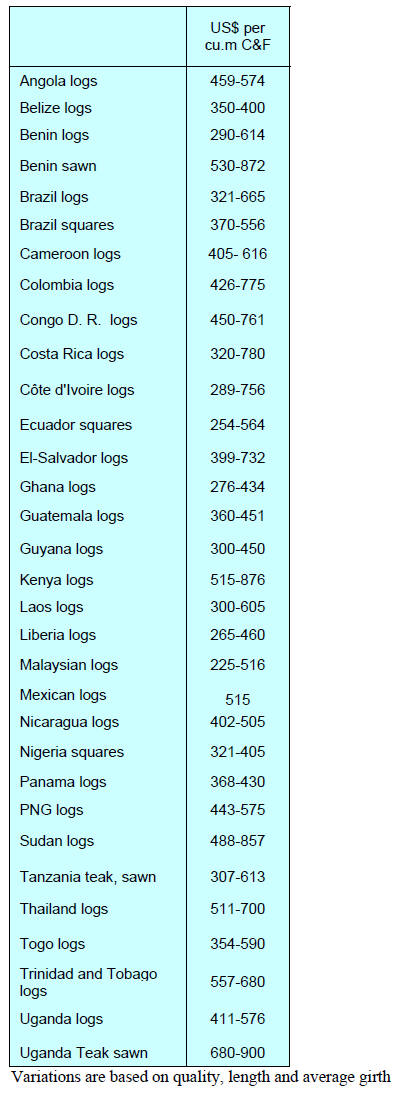
Prices for locally sawn hardwoods
No price rises have yet been reported but landed costs are
rising and an upward adjustment in price is expected if the
rupee continues to weaken.
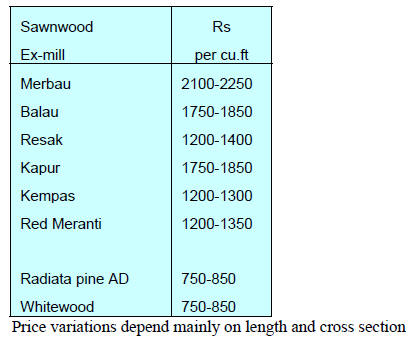
Myanmar teak flitches resawn in India
Imports of sawnwood and flitches from Myanmar are
helping maintain stocks. Analysts report rising landed
costs for certain specifications and this has translated into
higher on-selling prices.

Prices for imported sawnwood
Some price increases have been reported the result of the
depreciation of rupee.
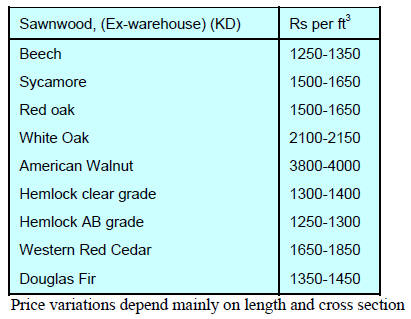
Plywood
Landed costs of imported plywood are rising due to the
weakening rupee but prices for locally manufactured
plywood remain unchanged. It has been reported that
plymills in southern India have been on improving the
quality of production which has lifted demand for their
shuttering plywood.

7.
BRAZIL
Domestic furniture retail sector
contracts in 2015
The Institute IEMI- Inteligência de Mercado recently
released data on the performance of the domestic furniture
market in 2015. This shows there was an almost 12% fall
in the value of retail sales compared to 2014.
An indicator for Industry Employment and Productivity
produced by IEMI showed that employment in the
furniture industry dropped by around 4% in December
alone and for 2015 productivity fell.
Brazilian furniture exports in 2015 were worth US$601.6
million, a 12.7% drop compared to 2014. Imports totalled
US$734.6 million in 2015, down 12.4% year on year.
Promotion of legal and certified timber in civil
construction
The Brazilian ‘Programa Madeira é Legal’ (Wood is
Legal) began 2009 with the aim of promoting the use of
legal and certified timber in private and public works in
the state of São Paulo.
A recent publication records the six-year history of the
initiative and claims that in the past a large volume of
timber came from deforested or illegally and unsustainably
logged areas and that the state and the city of São Paulo
were the largest consumers of tropical timber in the
country because of their huge construction sector.
To tackle issue of illegal timber being utilised the
programme promoted synergy between and improved
transparency in the different segments of the forest sector
to promote legal and certified timber in the state of São
Paulo. Through this the programme contributed to raising
awareness on the importance of procuring timber from
verified legal sources.
Increase in timber exports from Brazil to Mexico
Exports of Brazilian wood products to Mexico increased
55%, from US$18 million in 2010 to US$139 million in
2015. Amongst the top four countries exporting timber to
Mexico (United States, Chile, China and Brazil), Mexico’s
imports from Brazil achieved the highest growth rate.
According to the Mexican Association of Timber
Importers (IMEXFOR), the country needs to import
softwoods and tropical timber such as cedar, mahogany
and caobilla.
Mexico consumes around 20 million cubic metres of wood
annually but local production is less than 7 million cubic
metres. Mexico imports about mainly from the United
States and Chile and imports account for an estimated 90%
of plywood consumption while sawnwood accounts for
50%.
Growth of planted forest sector´s export
Despite the disappointing economic news from Brazil the
forest plantation sector had a good year in 2015.
Exports of pulp, wood panels and paper increased due to
the depreciation of the Brazilian currency against the
American dollar. Revenue from exports in 2015 totalled
US$7.8 billion compared to US$ 7.4 billion in 2014.
According to the Brazilian Tree Industry Association
(IBA), the sector’s trade balance in 2015 was US$6.5
billion, representing an increase of 17% compared to
2014. In 2016, the sector will continue to face the same
challenges as in 2015. In January 2016 revenue from pulp,
wood panels and paper exports totalled US$646 million, a
9.9% increase over the same period of last year.
In a web announcement Moody's global paper and forest
products industry outlook says ”the global paper and forest
products industry is stable and operating earnings growth
for publication producers in Latin America will remain as
last year.”
The announcement continues to point out that “depreciated
currencies will continue to mitigate weak international
prices and support local operating margins but that weak
economic expansion in Latin America will limit domestic
paper demand.”
See:
https://www.moodys.com/research/Moodys-Global-paperand-
forest-products-industry-outlook-stable--PR_345249

8. PERU
2015 exports fall 11.5 percent
2015 export data released by the Association of Exporters
(ADEX) shows that at US$151.31 million FOB there was
an 11.5% decline in wood product exports compared to
2014. Much of the decline, says ADEX, was the result of a
drop in sawnwood exports.
The top export products were mouldings, strips and
friezes, accounting for around 32% of the total. However,
2015 exports of these items were down almost 3% from a
year earlier.
Sawnwood exports came in as the second ranked item in
terms of value and accounted for 19% of exports. There
was a 40% drop in exports of sawnwood to China in 2015
compared to 2014. Despite purchasing less sawnwood,
China remained the main market for wood products from
Peru in 2015.
Exports to the Dominican Republic were encouraging in
2015 as was the level of exports to Mexico which was the
main market for sawnwood. The export of semimanufactured
wood in 2015 totalled US$70.84 million
FOB with China accounting for most at almost 70% of all
exports of this category of product.
Exports of veneer and plywood in 2015 were worth
US$15.29 million FOB, down almost 9% on 2014. The
main export markets were Mexico and the United States
but imports by Mexico were down over 7%.
Exports of furniture and parts were valued at US$6.72
million FOB in 2015, falling 14% compared to a year
earlier. The US was the main market for Peru’s furniture
and accounted for over 57% of all wooden furniture
exports. The second main market was Italy which
accounted for 15% of all furniture exports.
Higher market opportunities for legal timber
In the first week of March an event was held to discuss
opportunities for expanding trade in verified legal timber.
This event was organised by the National Forest and
Wildlife Service (SERFOR), and the Commission for the
Promotion of Exports and Tourism (PromPeru). The event
had the backing of GIZ under its ProAmbiente
Programme.
See:
https://www.giz.de/en/worldwide/13376.html
The topics addressed included market opportunities for
certified legal products and trade opportunities for
underutilised timber species. The meeting was attended by
representatives from those public institutions involved in
monitoring the chain of custody.

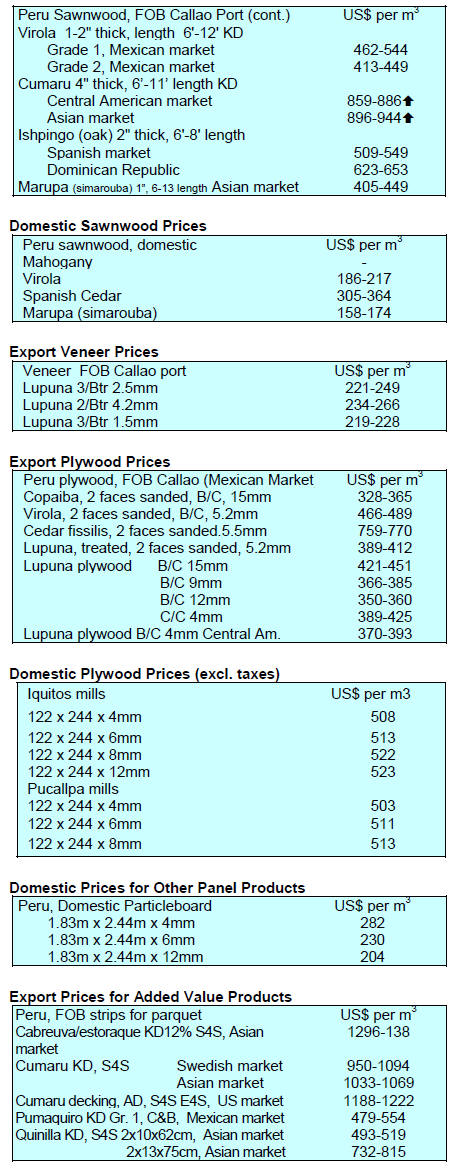 ANA
ANA
